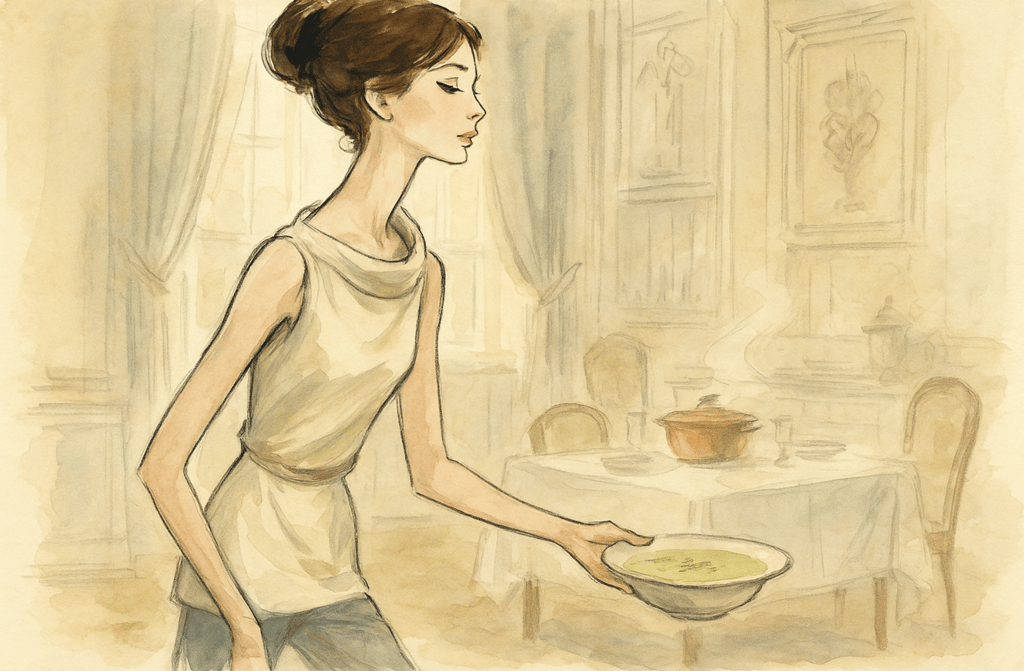The Rise of the Cold Soup: How Vichyssoise Helped Louis XV Beat the Heat
Vichyssoise, the classic cold leek and potato soup, began in Louis XV’s sweltering palace kitchens. Discover how this chilled dish became a symbol of summer luxury.
FOOD HISTORY & TRADITIONS


French cuisine is often associated with rich sauces, steaming broths, and lavish roasts served in glittering dining halls. But one of France’s most elegant dishes—vichyssoise, a chilled leek and potato soup—emerged not from indulgence alone, but from a very practical problem: how to keep a royal court comfortable in the stifling heat of summer.
In the 18th century, the grand kitchens of Versailles, where Louis XV’s chefs worked day and night to supply endless banquets, became near-unbearable in the height of July and August. The massive hearths roared constantly, sending waves of heat through the palace, while courtiers sweltered under layers of silk and brocade. Cooling the king and his guests wasn’t just about comfort; it was about survival and morale.
The solution? A simple yet sophisticated innovation: cold soup.
How the Royal Kitchens Reinvented Soup
Soup was a cornerstone of French dining, from rustic peasant broths to refined consommés that opened formal meals. But serving it hot in midsummer was hardly appealing. To combat the oppressive heat, palace chefs began experimenting with ways to make soups that were refreshing rather than warming.
One of their greatest successes was a puréed blend of leeks, potatoes, cream, and stock, served chilled. The ingredients were humble—vegetables commonly used in everyday cooking—but the preparation elevated them. By straining and puréeing the mixture into a velvety texture and balancing it with just enough seasoning, the chefs transformed everyday produce into something elegant enough for the king’s table.
This chilled soup offered immediate relief, soothing courtiers overheated by both the weather and the intensity of the palace’s endless entertainments. It was a reminder that even the simplest foods could become haute cuisine when prepared with skill and served at the right moment.
From Versailles to the World
Though the exact recipe evolved over time, the concept of a chilled leek and potato soup remained popular among the French elite. The dish gained its modern identity in the 20th century when Louis Diat, a French chef at New York’s Ritz-Carlton, adapted it for American diners. Diat named the soup “vichyssoise” after Vichy, a spa town in central France famous for its cool mineral springs, linking the dish to the notion of refreshment and vitality.
Diat’s version, which debuted in the 1910s, closely resembled its royal ancestor but with a richer finish of cream, making it indulgent as well as cooling. Served in fine dining rooms, vichyssoise became synonymous with sophistication and summertime luxury, eventually cementing its place as a staple in French-inspired cuisine around the globe.
Why Cold Soup Captured the Imagination
The appeal of vichyssoise goes beyond temperature. It embodies a balance of contrasts that French cuisine celebrates: humble ingredients elevated through technique, simplicity paired with indulgence, comfort food made elegant.
In the context of Louis XV’s court, it also symbolised adaptability. French culinary tradition was built on grandeur, but in the face of sweltering summers, innovation mattered more than pomp. By breaking from the expectation of steaming dishes, the chefs at Versailles not only kept their king comfortable but also introduced a new way of thinking about how food could serve the body as well as the palate.
Fun Fact: The Spa Town Connection
The name “vichyssoise” doesn’t trace directly to Versailles but to the spa town of Vichy, known for its mineral-rich waters and reputation as a place of rejuvenation. Associating the soup with Vichy was a clever nod to its cooling, restorative nature—a dish designed not just to please, but to refresh.
From Palaces to Kitchens Everywhere
Today, vichyssoise remains a symbol of summer sophistication. It’s often served as a first course at warm-weather dinners, sometimes garnished with chives, a swirl of cream, or even caviar for extra flair. While purists stick to the leek-and-potato base, modern variations include additions like fennel, asparagus, or even lobster, proving the dish’s flexibility as much as its staying power.
But its royal origin story remains part of its charm. This chilled soup isn’t just a culinary curiosity—it’s a reminder that some of the most timeless dishes are born from practical needs, not just artistic ambition. In the kitchens of Versailles, innovation meant finding ways to comfort a king. In our kitchens today, it means finding a way to enjoy rich, satisfying flavours without breaking a sweat.
The next time you ladle out a bowl of vichyssoise, consider its journey: from the roaring hearths and sweltering halls of Versailles to the cool tables of modern dining rooms. It’s not just a soup. It’s a taste of how necessity can spark elegance.
